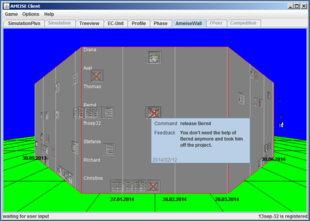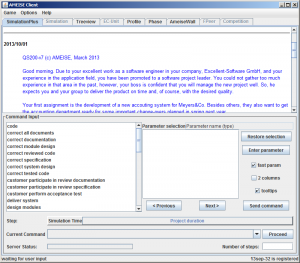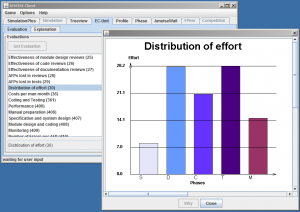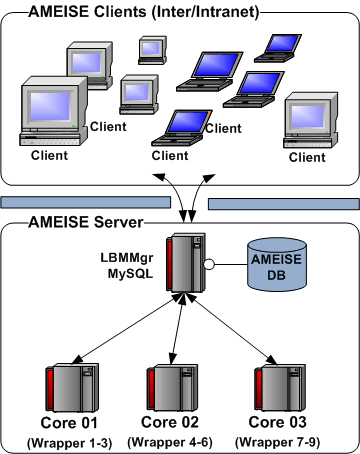About The Project

The AMEISE-System provides students of informatics, business informatics and economics as well as subject-related university or college-studies, the ability to collect project management experience on a simulator. Critical situations can be defined and trained with AMEISE without getting a real project in danger.
Future project-leaders can execute projects in a few hours that would normally take several months. They also get confronted with typical problems of projects and should solve them.
Currently the AMEISE system offers three different models: a Beginner-Model (Mini model, with less requirements), a Standard model (with a particular focus on quality assurance), and a Maintenance-model (which is based on the activities after delivering the product). AMEISE is more than a simulator. The instructor can activate many different components, for example the advisor or evaluation components. A special feature is the ability to reset the simulation run at a certain point in time(rollback). Thereby different variants can be tested by the project leader (for example change developers or using a different strategy) and then the results can be compared.
Started in 2001 as part of a nml project from bm:bwk / Austria, AMEISE is and has been used at several Universities and Colleges in Austria, Germany and the Maghreb region. The heart of the AMEISE-system is (SESAM) which was developed at the University of Stuttgart (Prof. Jochen Ludewig) and its related Quality Assurance Models (also referred to as QA-models).
Components of the Project
AMEISE is a Client-Server System which can be executed locally on a computer or distributed in intranet or internet. The system is designed so that even unstable environments have no effect on the simulation runs. As a trainee you can use the AMEISE client to manage a virtual project which means to delegate tasks, do project control and, of course, to deliver a product of acceptable quality at the end of the simulation run.
Client

The AMEISE client provides a graphical interface for trainees and is implemented as a Java-application that runs virtually on every platform. Comment inputs and feedbacks are usually text-based, but to make the inputs more comfortable there is a mouse-based version available:
- SimulationPlus. After a successful authentication, a window appears which contains the feedback from the simulator in the upper part and the available commands in the lower part. There, commands can be entered (and combined), and responses from the simulation environment can be followed. One is also able to advance the simulation time per day.
Project managers can choose between the different available commands to manage the tasks of the developers or to get informed about the project status. Literally, there are now restrictions to the order the command are used and managers can choose among them freely. However, that means that managers (as in real life) can start reasonable as well as unreasonable activities at any time – yielding situations which have positive or negative effects on the project run.
The AMEISE Client provides an interface for the simulator but also many supervisory components supporting the learning process during and after the simulation run. They can be activated or deactivated by the instructor.
- Explanation component - Advisor. This component imitates an “experienced employee in the next office” whom you can ask questions about your project.
This “experienced employee” looks at your performance and gives you feedback to single project phases and the product. This component is deactivated during a simulation run by default.

- Explanation component - Evaluation. This component analyzes your current project status and generates diagrams and tables to give you an overview about your project. You can get information about your performance, the employees used and the quality of your interim - and final products. Usually, this component is deactivated during a simulation run, and activated quite after the end of your project, allowing for an immediate self-assessment.
- Friendly Peer. This component imitates an “experienced employee sitting in your office”. You can use the friendly-peer as an observer during the simulation run. The friendly-peer gives you advices in tricky situations and warns you when steering the project into the wrong direction. The component is disabled by default and has to be enabled by the instructor.
The SimulationPlus component can be combined with the following interfaces to get an even better sight onto your project.
- AmeiseWall. For a better overview of your project you can use this component to see the set activities in form of a Perspective Wall. The activities appear as small icons ordered by employees over time.
- TreeView. AMEISE allows for undoing commands (please note, for didactical reasons it is strongly recommended not to use this feature in the first runs). Therefore different paths in a project are possible. The TreeView component represents these paths in the form of a tree.
- PhaseView. In contrast to the TreeView component (which represents each simulation step), the PhaseView component offers a phase-oriented perspective. Bars represent commenced and completed phases of the project.
Server
The core of AMEISE is the AMEISE server, a Java application with an SQL database in the background. Apart from the database, the server consists of two different applications: the simulation core (Wrapper) and the load balancing manager (LBMMgr).
- AMEISE Wrapper. This component represents the simulation engine written in ADA95. The simulation engine is a single-user system. So, the AMEISE Wrapper embeds the simulation engine in a Java application and makes it multi-user capable. It also collects simulation data and writes it into the database. Depending on the workload, AMEISE can make use of several wrappers in parallel.
- LBMMgr (Load Balancing Manager). Actually, as several Wrapper machines might be available, a load distribution manager ensures that every AMEISE-client has access to the least occupied simulation engine. Behind a firewall, the LBMMgr is also the interface to the outside and acts as a proxy for requests.
Models
The didactical core of AMEISE (as well as of SESAM) is the collection of simulation models and its explanatory texts. Models of AMEISE are largely based on the quality assurance model which was designed by our partners at the University of Stuttgart. The underlying model is a waterfall-like model focusing on quality and quality assurance measures. The rules behind the model are based on a wide range of empirically validated data.
- Quality assurance model
* Mini model. This model is used to get acquainted with the simulator and the user interface. The management objectives are reduced to a project with almost now complexity(project with only 3000 LOC, 3 fixed employees, sufficient time and budget) so that user can focus on learning how to interact with the simulation environment. The model was defined at the University of Klagenfurt.
* Standard model. This model corresponds to the basic Quality Assurance Model of Stuttgart(called QA200). The project head has to manage a project within 9 months and 225,000 EUR of budget. The project size is about 200 [Adjusted Function Point] .
- Further models
* Maintenance model. This model, created at the University of Linz, is related to the standard QA200 model, but the focus is on maintenance activities. At irregular intervals maintenance tasks (corrective and preventive) are triggered, and have to be managed by the project manager.
The History
The basics of AMEISE were developed during an nml (New Media in the Teaching) project of bm:bmwk, Austria in 2001 and go back to a conference presentation of SESAM by Prof. Jochen Ludewig (from the University of Stuttgart). The objective of the AMEISE project was to extend SESAM in such a way that it could be used with larger groups, meaning that an automated analysis of the results got inherently necessary. Started at the University of Klagenfurt (Prof. Mittermeir, Dr. Bollin), soon the Carinthia University of Applied Sciences (Prof. Hochmüller), the University of Linz (Prof. Chroust) and the University of Stuttgart (Prof. Ludewig) joined the AMEISE team.
The development phase, where a client / server architecture was built, lasted from 2001 to 2003. The use of free software (GPL based) and Java enabled broadest possible platform independence, but also led to many technical problems (going back to a lack in documentation of the free software) during the maintenance phase. It took us 3 years (from 2003 to 2006) to overcome all the problems and to stabilize the system. Despite the projects’ official end in 2006, AMEISE is being further developed and is the basis for several ongoing projects and dissertations.
Since 2002, the AMEISE is in use at the project sites and partially embedded in the respective curricula. Since 2004, AMEISE is and has been used at partner Universities in Germany and Slovakia. In 2004, AMEISE was also part of an EU-MEDIDA project and was used in the Maghreb region.
Technical Requirements

AMEISE can be used in two different ways. Either one uses the AMEISE server of the University of Klagenfurt (to be agreed upon) and only installs the AMEISE client locally, or one installs the whole system (server and client) locally. AMEISE can now also be installed on a single computer (including laptops) for demonstration purposes, but in a course a distributed system is recommended.
Depending on the situation on site, the technical requirements are different. The following rules of thumb can be given:
- Client.
The client is available as a Windows executable or as a Java application (for Linux, MacOS, Solaris and Windows). The sole requirements are the mentioned operating systems, network access (at least to the AMEISE Server) and Java JDK 5.
- Server.
The server consists of three sub-components: the database, the load balancing manager (LBMMgr) and one or more simulation cores (Wrapper):
* Database. You need a free SQL database mysql in version 5.1 (innodb-Type to be transaction-safe). Rule of thumb: every simulation run (Client user) requires 60MB of disk space.
* Load balancing manager (LBMMgr). It is available for Linux, Solaris and Windows as a Java application. At least Java JDK 1.4, 50MB of RAM and approximately 10MB of hard disk space(for logs) are required.
* Simulation core (Wrapper). The Wrapper is available for Linux, Solaris and Windows as a Java application. For Linux and Solaris, you need the gnat95 libraries installed on the system. Java JDK 1.54 or above is required (please note, JDK 7 is possible but reported to be instable sometimes!). In order to increase the simulation performance during a course, several Wrappers should be installed in parallel. The rule of thumb: For every 5 clients used in the course, one wrapper should be installed. For every Wrapper, 500MB RAM and 10 MB of disk space are required.
Further questions?
I want to know more about the project
I want to work on the project
- see Contacts
I want to download AMEISE
- see Download
What’s new in the AMEISE-project?
- see News